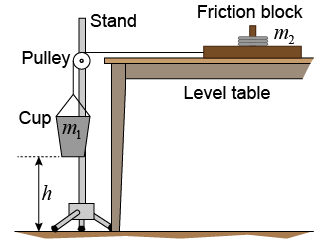|
| Essential questions | | What determines the force of friction? | |
|
Friction is everywhere and can be either helpful or wasteful depending on the situation. In this investigation you will test models of friction against actual measurements to get a sense of how accurate these friction models are. 
|
Part 1: Coefficient of static friction using a friction block

- Set up the experiment with string, mass (cup), friction block, and a pulley as shown.
- Add mass to the cup or remove mass from the friction block until the friction block just starts to slide when you release it. (Be sure to brush any dust or grit from the surfaces before each trial.)
- Use the spring scale to weigh the cup and the friction block (with its mass).
- Change masses and repeat the experiment a second and third time, recording all measurements in scientific notation and correct SI units.
- Write a hypothesis about models for static and kinetic friction that your investigation will test.
- Draw a free-body diagram of the block. Label all forces that act on it, including friction.
- Derive an equation for the coefficient of static friction in terms of the weights of the falling mass and friction block.
- Determine the coefficient of static friction for each of the trials you performed.
- The model for static friction treats μs as approximately constant, even as the mass of the friction block increases. Analyze this model using your experimental data of the percentage variation between each trial’s results.

|
Part 2: Coefficient of kinetic friction
- Adjust the masses of the cup and/or friction block until you observe a noticeable acceleration of the friction block across the table.
- Measure and record the masses and the height h the cup drops from its maximum possible height directly under the pulley. Mark the table with tape so you can start the block at the same place each time.
- Release the friction block and measure the time t it takes for the cup to fall the distance h. Do several trials.
- Use the equations of motion to derive an equation for the average acceleration of the block in terms of the time t it takes the cup to fall and the height h.
- Use Newton’s second law to determine the net force acting on the total system (of block plus falling cup) from the mass of the system and the acceleration.
- Calculate and record the force of kinetic friction for each trial. Show the equation you used.
- Calculate the coefficient of kinetic friction for each of your trials. Show the equation you used.
- Based on your experimental results, critique the models for static and kinetic friction. Do your data support your hypothesis or not?
- Compare your data to the tabulated coefficients of static and kinetic friction on page 154. Using your data, evaluate the precision of the tabulated coefficients.

|
|
This interactive tool can be used as a stopwatch to time how long it takes for the mass to fall to the floor from a height h.
|

